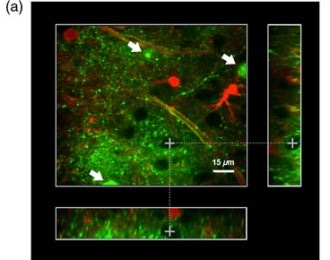Mar 3 2017
 A new optical nanosensor enables more accurate brain mapping and opens the way for broader applications in future; Fig. 5. in a paper reporting on the work shows retention of a potassium nanosensor in the extracellular space. (doi:10.1117/1.NPh.4.1.015002)
A new optical nanosensor enables more accurate brain mapping and opens the way for broader applications in future; Fig. 5. in a paper reporting on the work shows retention of a potassium nanosensor in the extracellular space. (doi:10.1117/1.NPh.4.1.015002)
Researchers report, in an article published in the recent issue of Neurophotonics, that a new optical nanosensor enabling more accurate measurement and spatiotemporal mapping of the brain is also capable of paving the path towards the design of future multimodal sensors and a wider range of applications. The journal is published by SPIE, the global society for optics and photonics.
Neuronal activity causes the discharge of ionized potassium into extracellular space. Under active pathological and physiological conditions, elevated levels of potassium must be swiftly controlled to enable succeeding activity. This entails diffusion of potassium across extracellular space and re-uptake by astrocytes and neurons.
Measuring potassium levels discharged during neural activity has required potassium-sensitive microelectrodes, and so far has provided only single-point measurement and approximate spatial resolution in the extracellular space.
A research team from the University of Lausanne used a fluorescence-imaging-based ionized-potassium-sensitive nanosensor design to overcome hurdles such as drift and diffusion of dyes within the examined region or sensitivity to small movements, thus enhancing accuracy and enabling access to formerly unreachable areas of the brain.
The research by Joel Wellbourne-Wood, Theresa Rimmele, and Jean-Yves Chatton is detailed in "Imaging extracellular potassium dynamics in brain tissue using a potassium-sensitive nanosensor." The research article can be downloaded for free.
This is a technological breakthrough that promises to shed new light - both literally and figuratively — on understanding brain homeostasis. It not only is much less invasive than previous methods, but it adds a crucial spatial dimension to studies of the role of potassium ions in brain function.
This potassium-sensitive nanosensor has the potential to aid future studies of chemical mechanisms and their interactions within the brain, the researchers emphasize. The spatiotemporal imaging developed by gathered data will also allow for exploration into the probable existence of potassium micro-domains around activated neurons as well as the spatial extent of these domains.
The research validates the nanosensor’s practicality for imaging in the extracellular space, and also draws attention to various probable extensions and applications of the nanosensor strategy.
David Boas of Massachusetts General Hospital, Harvard Medical School, is the editor-in-chief of Neurophotonics. Neurophotonics, launched in 2014, is published digitally in the SPIE Digital Library and in print. The journal covers advances in optical technology applicable to the research of the brain and their impact on fundamental and clinical neuroscience applications.
The SPIE Digital Library contains over 458,000 articles from SPIE journals, proceedings, and books, with nearly 18,000 new research papers added annually. Abstracts are freely searchable, and a number of journal articles are published with open access.